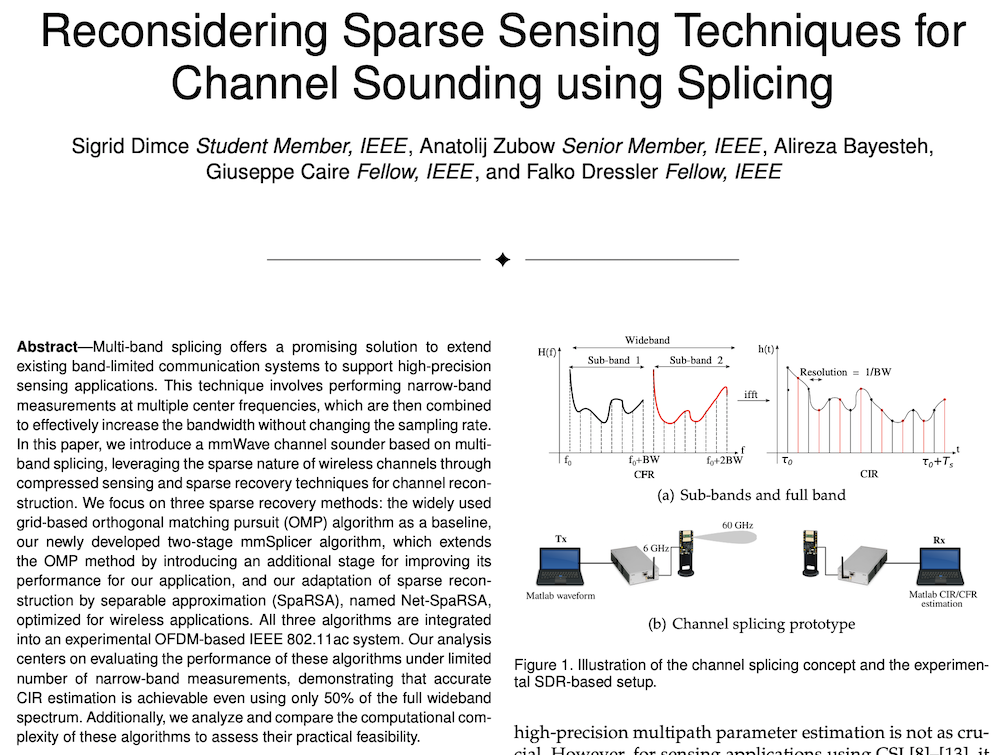Literature Database Entry
zubow2019deepctc-preprint
Anatolij Zubow, Piotr Gawłowicz and Suzan Bayhan, "Deep Learning for Cross-Technology Communication Design," arXiv, cs.NI, 1904.05401, April 2019.
Abstract
Recently, it was shown that a communication system could be represented as a deep learning (DL) autoencoder. Inspired by this idea, we target the problem of OFDM-based wireless cross-technology communication (CTC) where both in-technology and CTC transmissions take place simultaneously. We propose DeepCTC, a DL-based autoencoder approach allowing us to exploit DL for joint optimization of transmitter and receivers for both in-technology as well as CTC communication in an end-to-end manner. Different from classical CTC designs, we can easily weight in-technology against CTC communication. Moreover, CTC broadcasts can be efficiently realized even in the presence of heterogeneous CTC receivers with diverse OFDM technologies. Our numerical analysis confirms the feasibility of DeepCTC as both in-technology and CTC messages can be decoded with sufficient low block error rate.
Quick access
Original Version ![]() (at publishers web site)
(at publishers web site)
Authors' Version ![]() (PDF on this web site)
(PDF on this web site)
BibTeX ![]()
Contact
Anatolij Zubow
Piotr Gawłowicz
Suzan Bayhan
BibTeX reference
@techreport{zubow2019deepctc-preprint,
author = {Zubow, Anatolij and Gawłowicz, Piotr and Bayhan, Suzan},
doi = {10.48550/arXiv.1904.05401},
title = {{Deep Learning for Cross-Technology Communication Design}},
institution = {arXiv},
month = {4},
number = {1904.05401},
type = {cs.NI},
year = {2019},
}
Copyright notice
Links to final or draft versions of papers are presented here to ensure timely dissemination of scholarly and technical work. Copyright and all rights therein are retained by authors or by other copyright holders. All persons copying this information are expected to adhere to the terms and constraints invoked by each author's copyright. In most cases, these works may not be reposted or distributed for commercial purposes without the explicit permission of the copyright holder.
The following applies to all papers listed above that have IEEE copyrights: Personal use of this material is permitted. However, permission to reprint/republish this material for advertising or promotional purposes or for creating new collective works for resale or redistribution to servers or lists, or to reuse any copyrighted component of this work in other works must be obtained from the IEEE.
The following applies to all papers listed above that are in submission to IEEE conference/workshop proceedings or journals: This work has been submitted to the IEEE for possible publication. Copyright may be transferred without notice, after which this version may no longer be accessible.
The following applies to all papers listed above that have ACM copyrights: ACM COPYRIGHT NOTICE. Permission to make digital or hard copies of part or all of this work for personal or classroom use is granted without fee provided that copies are not made or distributed for profit or commercial advantage and that copies bear this notice and the full citation on the first page. Copyrights for components of this work owned by others than ACM must be honored. Abstracting with credit is permitted. To copy otherwise, to republish, to post on servers, or to redistribute to lists, requires prior specific permission and/or a fee. Request permissions from Publications Dept., ACM, Inc., fax +1 (212) 869-0481, or permissions@acm.org.
The following applies to all SpringerLink papers listed above that have Springer Science+Business Media copyrights: The original publication is available at www.springerlink.com.
This page was automatically generated using BibDB and bib2web.





